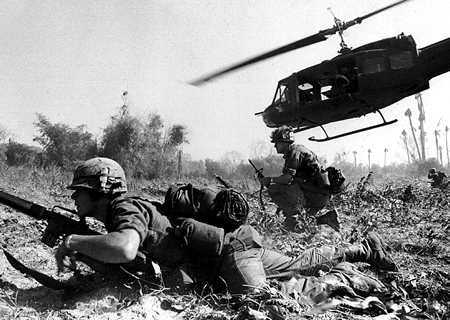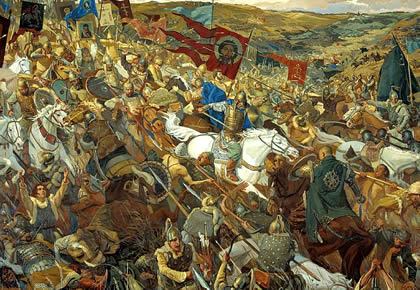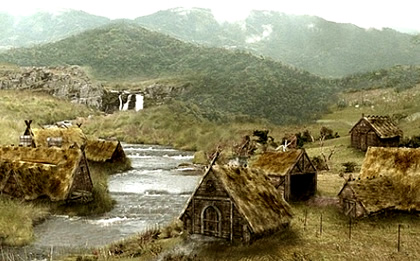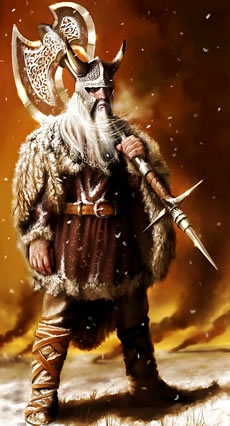The NATO alliance is dedicated to the maintenance of the democratic freedoms and territorial integrity of its 26 European and North American member countries through collective defense.
This alliance has been the dominant structure of European defense and security since its founding in 1949 and continues to serve as the most formal symbol of the United States’ commitment to defend Europe against aggression. Following the end of the cold war, the organization also took on a peacekeeping and stabilizing role within Eurasia.
NATO was founded with the Washington Treaty of April 4, 1949, which was signed by Belgium, Canada, Denmark, France, Iceland, Italy, Luxembourg, the Netherlands, Norway, Portugal, Great Britain, and the United States.
 |
The 12 founding members were later joined by 14 others, including Greece and Turkey, which allowed the alliance to secure the Mediterranean. From the outset, NATO was intended to deter Soviet expansion into central and western Europe.
The Washington Treaty reflected the will of the signatories to further democratic values and economic cooperation, to share the obligations of defense individually and collectively, to consult together in the face of threats, to regard an attack against one member as an attack against all members, and to collectively and individually assist the victims of an attack.
The treaty also delineated the geographic boundaries of the alliance, created the North Atlantic Council to implement the treaty, made provisions for new members to join, governed ratification according to constitutional processes, and made provisions for review of the treaty.
NATO’s civil and military organization materialized during 1949–95. The basic structures developed during this period remained into the 21st century. The civilian headquarters for the North Atlantic Council (NAC), which maintains effective political authority and powers of decision in NATO, is located in Brussels, Belgium.
NATO’s secretary-general chairs the NAC and oversees the work of the International Staff (IS). Member countries maintain permanent representatives. The council serves as a forum for frank and open diplomatic consultation and the coordination of strategic, defense, and foreign policy among the alliance members.
Action is agreed upon on the basis of common consensus rather than majority vote. Twice a year the defense ministers of the member countries meet at the NAC, and summit meetings involving the heads of state of each member country occur, during which major decisions over grand strategy or policy must be made.
After the end of the cold war, the NAC was supplemented by the Euro-Atlantic Partnership Council (EAPC) as well as the NATO-Russia Joint Council. These newer bodies facilitate peaceful coordination and cooperation between NATO and the Russian Federation and other former members of the Soviet-led Warsaw Pact alliance.
The secretary-general of NATO also chairs the Defence Planning Committee (DPC), which is tasked with planning for the collective defense of the member countries. The DPC provides guidance to the alliance’s military authorities to improve common measures of collective defense and military integration. The DPC consists of the permanent representatives; like the NAC, the DPC also serves as a forum for meetings between the defense ministers of the member states twice a year.
The senior military representatives of the member states form the Military Committee. The Military Committee is subordinate to the NAC and consists of the chiefs of staff of the member nations, who advise the NAC on all military matters and who oversee the implementation of the measures necessary for the collective defense of the North Atlantic area.
The committee is supported by the International Military Staff (IMS), which meets twice a year at chiefs of staff level and more often at the national military representatives level. Until 2003 operational control of military forces operating under the NATO flag fell to Allied Command Europe and Allied Command Atlantic.
In 2003 NATO undertook a major restructuring of its military commands. The Supreme Headquarters Allied Powers Europe (SHAPE) became the Headquarters of Allied Command Operations (ACO). ACT is tasked with driving transformation in NATO and establishing future capabilities, while ACO is responsible for current operations.
Throughout the cold war NATO faced a powerful counter-alliance in the Warsaw Pact and turmoil within the organization itself. Indeed, in 1949 the alliance members could only marshal 14 divisions of military personnel against an estimated 175 Soviet divisions.
At the NAC meeting in 1952, the members established a goal of fielding 50 divisions backed up by several thousand aircraft by the end of the year and 96 divisions by 1955. Also in 1952 the alliance introduced a new strategic concept: mass conventional defense of Europe coupled with long-range nuclear strikes against the Soviet Union and other Warsaw Pact members.
However, the cost of raising the 96 divisions required to implement this strategy proved too great, and it was quickly abandoned. In 1953 Dwight Eisenhower put forward a new strategy, which focused more on nuclear deterrence.
The new strategy came to be known as "massive retaliation" and would have involved extensive use of nuclear weapons against the Soviet Union and eastern Europe if their forces had broken through NATO’s conventional defenses in central Europe.
Nuclear crises over Berlin and Cuba in the late 1950s and early 1960s suggested a need for a more gradual strategy than massive retaliation. President John F. Kennedy endorsed a strategy of "flexible response" in 1961–63, which favored deploying more conventional forces in central and northern Europe from both the United States and the other NATO members.
Disagreement over this new strategy led France to withdraw from NATO’s integrated military command structure in 1967. NATO adopted a new doctrine in December 1967, which endorsed a flexible conventional and nuclear response to Soviet aggression. At the same time, the NAC adopted a new grand strategy favoring stable and peaceful relations with the Warsaw Pact countries.
NATO was further challenged in the mid-1970s when the Soviet Union deployed large numbers of intermediate-range nuclear missiles in Europe that were capable of striking all of the European NATO allies.
In response the members agreed to deploy Pershing II and cruise missiles in West Germany, the United Kingdom, the Low Countries, and Italy. However, a more cordial relationship between the alliance and the Warsaw Pact during the 1980s led to the dismantling of these intermediate weapons at the end of that decade.
After the end of the cold war, NATO retained several important formal and informal functions. First, it serves as a permanent and institutionalized link between the United States and an ever-growing number of European allies. In addition, it prevents the renationalization of European defense policies.
Moreover, NATO allows an institutionalized relationship with Russia and several of the former Warsaw Pact countries that have yet to join the alliance. Finally, it serves peacekeeping and stability functions in Europe and Asia.
NATO invoked article 5 of the Washington Treaty for the first time following the September 11, 2001, attacks against the United States. Many NATO countries participated in the U.S.-led war in Afghanistan against al-Qaeda and the Taliban.




















